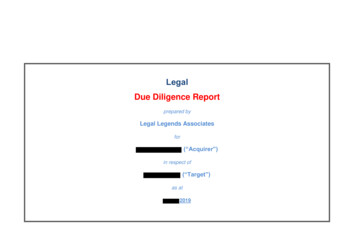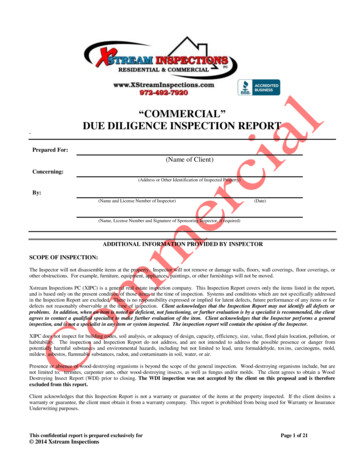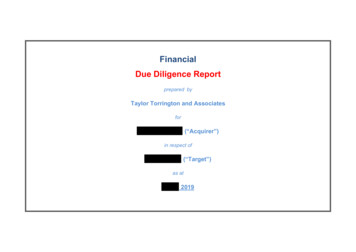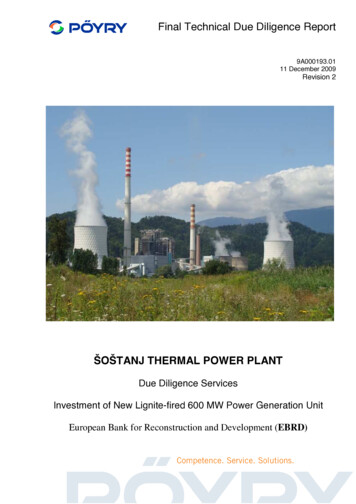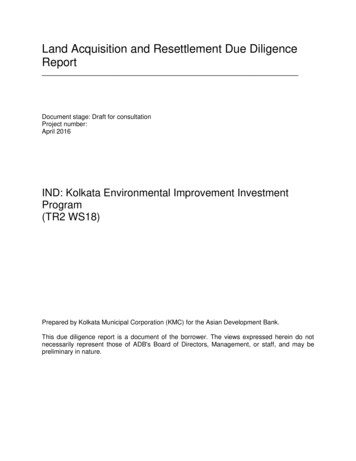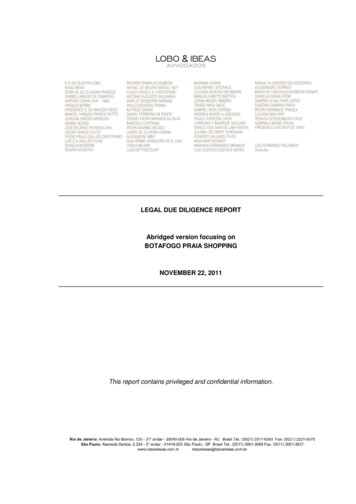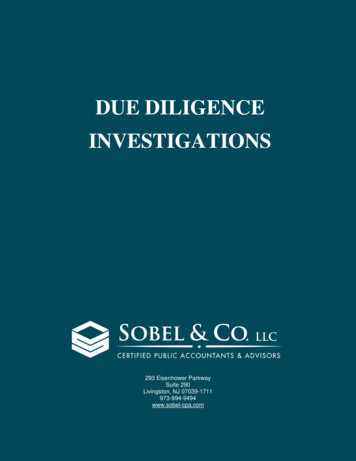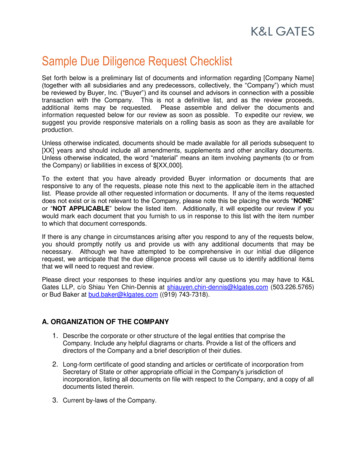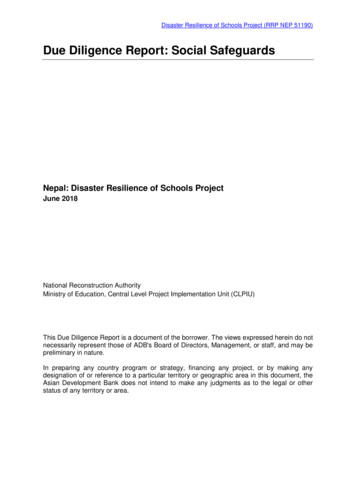
Transcription
Disaster Resilience of Schools Project (RRP NEP 51190)Due Diligence Report: Social SafeguardsNepal: Disaster Resilience of Schools ProjectJune 2018National Reconstruction AuthorityMinistry of Education, Central Level Project Implementation Unit (CLPIU)This Due Diligence Report is a document of the borrower. The views expressed herein do notnecessarily represent those of ADB's Board of Directors, Management, or staff, and may bepreliminary in nature.In preparing any country program or strategy, financing any project, or by making anydesignation of or reference to a particular territory or geographic area in this document, theAsian Development Bank does not intend to make any judgments as to the legal or otherstatus of any territory or area.
TABLE OF CONTENTSi.INTRODUCTION. 1ii.APPROACH AND METHODOLOGY IN DUE DILIGENCE . 1iii.SCOPE OF LIKELY IMPACTS OF THE PROJECTS . 2A. Involuntary Resettlement . 2B. Indigenous Peoples . 3C. Impacts of Village Trails Passes through Schools . 4iv.SITE OBSERVATION AND CONSULTATIONS . 4v.CONCLUSION AND RECOMMENDATIONS . 4Annex 1: Involuntary resettlement impact screening checklist of sample Schools . 6Annex 2: IP impact screening checklist of sample Schools (subprojects) . 7Annex 3: Details list of participants during consultation meeting . 8Annex 4: Scanned copies of land ownership certificate & occupancy rights (as sampleof a few school, individual school’s detail is included in individual DDR of the school) 17Annex 5: Indicative Sample Documents of current school enrolment by caste and ethnicgroup (Details of each school in individual school DDR) . 30Annex 6: List of School Selected for First Batch (Recon 1) under DRSP & their LandOwnership Status . 39Annex 7: Sample Master Plans of School. 45
CURRENCY EQUIVALENTS(As of 1 January 2018)Currency UnitNRs 1.00 1.00- Nepalese Rupee (NRs) 0.0097991NRs 102.05WEIGHTS AND MEASURESKilometer - NGRCGRMIFBMOESTNGONRAO&MPPTAPMUSPSSMCTORAsian Development BankCentral Level Project Implementation UnitConcerned Sector AgencyComprehensive School Safety FrameworkDistrict Level Project Implementation UnitDepartment of EducationDisaster Risk ManagementDesign and Supervision ConsultantsEducation Management Information SystemGovernment of NepalGrievance Redress CommitteeGrievance Redress MechanismInvitation for BidMinistry of Education, Science and TechnologyNongovernmental OrganizationNational Reconstruction AuthorityOperation and MaintenanceProject Preparation Technical AssistanceProject Management UnitSafeguards Policy Statement 2009School Management CommitteeTerms of ReferenceNoteIn this report, " " refers to US dollars unless otherwise stated
I.INTRODUCTION1.The Disaster Resilience of Schools Project (DRSP) will reconstruct and retrofit about174 secondary school buildings to earthquake-resistance standard that were damaged by thedevastating 2015 Gorkha earthquake in Nepal. These schools have been selected based onthe total enrollment, the scale of the physical damages incurred, and the proportion of girlsand underprivileged students. They are located in 14 districts affected by the earthquake. Theinvestment works will also include the provision of laboratories, information communicationand technology, library, gender segregated toilets, and amenities designed to mitigate otherpotential weather-related disaster and ensure a safe learning environment. Along with theinfrastructure investments, the project will train the school management and communities toincrease awareness and reduce exposure and vulnerability to natural disaster.2.The project (DRSP) with the following impact: disaster risk management for humanresource development enhanced. The expected project outcome is: disaster resilience ofschools and communities increased and learning environment improved. The three expectedproject outputs are: (i) heavily damaged schools reconstructed and improved; (ii) unsafeschools retrofitted and disaster risk reduced; and (iii) institutional capacity for disasterresilience strengthened.3.This due diligence report (DDR) has been prepared covering 67 schools likely to beconsidered for first batch financing to assess the likely social impacts of the subprojects asper the applicable government policies/procedures and ADB Safeguard Policies as observedduring the site visits as well as the information received from CLPIU and DLPIU.4.The main objective of the DDR is to assess the land availability, ownership status ofthe schools selected for first batch reconstruction of buildings and assess likely social impactsdue to implementation of the proposed reconstruction activities with respect to landacquisition, compensation and involuntary resettlement, common properties (if any) and interms of displacement, loss of incomes, and restriction on access to private properties andcommon community resources.II.APPROACH AND METHODOLOGY IN DUE DILIGENCE5.As part of the due diligence, a desk review of the project concept notes, project DPR,design, drawings were carried out. ADB's safeguard policy requirements and government ofNepal's legal framework in relation to social safeguards were reviewed thoroughly foridentifying gap between ADB policy and GON legal framework. Consultation meetings wereorganized with central level stakeholders (CLPIU and social safeguard expert and team leaderand members of DSC). Focused group discussions, consultation meetings and formal andinformal discussions with district and school level stakeholders were conducted during thefield study1. The details of the participants participated in the discussion have been providedin Annex 3. Due diligence assessment of the likely involuntary resettlement and indigenouspeople impacts were carried out on the basis of desk review, information and documentsprovided by the central level project implementation unit ( CLPIU) and District level projectimplementation unit (DLPIU) and interviews and discussions with school teachers, membersof the school management committee (SMC), representatives of newly elected localgovernments, students, parents and local communities and other stakeholders whileconducting site observation and verification. A construction master plan has been prepared1A field visit plan was prepared discussing with CLPIU and DSC team along with PPTA team leader includingenvironmental and GESI experts. The social safeguard consultant visited the project areas in two phases. Thefirst phase of field study was conducted in Ramechhap and Dolakaha districts on November 8-13, 2017 and 2ndphase of field visit was conducted in Sindhupalchowk and Bhaktapur districts on December 5-6, 2017. Similarly,DSC consultant conducted field study of all 76 selected schools for first batch.
2for identified schools and total land requirements have been assessed following scope of themaster plan. Each school selected for reconstruction or retrofitting will be considered assubproject.6.All 67 schools selected2 for 1st batch of Reconstruction have been selected for duediligence of the involuntary resettlement and indigenous people impacts. The PPTA safeguardconsultant visited 9 schools at first and rest 58 schools were visited by design and supervisionconsultant (DSC) who were assigned for the detailed design of the schools. The DSC socialsafeguard specialist collected information from the field. After completion of first and secondphase of field study, information collected have been analyzed and substantiated with thefindings of desk reviews. Individual school due diligence report was prepared by the DSC andconsolidated DDR has been prepared based on information collected through field study andinformation extracted from individual school due diligence report. Details of land ownershipstatus of all 67 schools attached in Annex 6. The key findings from the first phase have beenfurther substantiated and verified during second phase of field study and came to conclusionthat all government schools more or less have similar types of land ownership pattern (eitherown land title or possess occupancy right from local government, establishment of schoolsthrough privately or publicly/community donated lands remains a the historical legacy inNepal but transfer of land ownership to school is still largely ignored ) and face more or lesssimilar types of issues. Thus, it is assumed that the findings of this due diligence assessmentwill be applicable for all schools under DRSP. However, a resettlement framework has beenprepared to provide policy and procedural guidance to address issues related to lands andindigenous people. Any unanticipated impacts and issue will be documented during theimplementation and mitigated based on provision made in the resettlement framework. Theimplementing agency (IA) and project implementation authorities has discussed and finalizedthe entitlements in line with the GON legal provisions and ADB’s SPS, 2009.III.A.SCOPE OF LIKELY IMPACTS OF THE PROJECTSInvoluntary Resettlement7.Field observation of the total 67 schools proposed for 1st batch, discussions with CLPIU,DSC, DLPIU and district DSC team members and review of design of the school buildingindicate that the construction activity will be confined within the existing boundaries of theschools having their own titled lands or occupancy right issued by local government. 66 shoolown lands (with landownership certificate) required for reconstruction of school buildings. Theland occupied by Shree Ma vi Jaymirekhani, Ramechhap is public (government) lands withevidence of occupancy from local government. Scanned copies of land ownership certificatesfor 8 schools and evidence of occupancy for one school have been attached in Annex 4. Thedue diligence of schools to be considered for first batch financing have sufficient land eitherhaving land ownership certificate or with land use right document within their existing boundary.However, it is estimated that implementation of master plan will affect existing access road/trailto village for about 10% of the total schools. It may impose restriction to the access. The hasconfirmed that access will be continued by shifting alignment and included in detailed designof the first phase schools and similar approach will be used for upcoming batches.8.The construction activity will be limited within the existing boundaries of the schools.According to the assessment of land availability for the proposed schools considered forproject design and readiness, there is no need of new land acquisition and there won't bephysical as well as economic displacement.2On the basis of following criteria: i) rank in the top of the multi-criteria selection system (XE); ii) above 200students; iii) equally distributed among districts to balance the supervision effort equally among districts and iv)If a school requires a combination of reconstruction and retrofitting, reconstruction will be considered for firstbatch.
39.During construction period, these schools may lack sufficient number of classrooms torun classes to all students and schools has to merge classes or conduct classes out in theopen to accommodate students. To overcome this problem, the establishment of the TLCshas been envisaged within the school compound or in the vicinity of the area. Since ShreeSecondary School, Jyamirekhani, Shree Secondary School, Sikral, Gelu and Shree AajadiSecondary School, Birauta, Melung does not have enough land to establish TLC within theirexisting school compound. Establishment of TLCs will help the students to continue their studyand the schools will have enough time to plan and reconstruct the damaged classrooms. SMCand local people will facilitate to get suitable site for TLC construction (if needed) and a leaseagreement will be carried out as per provision in resettlement framework.10.Based on the analysis of pattern of land availability of the first batch schools andconsidering the historical practices of school establishment in Nepal, the schools consideredfor funding by the project in the future are also unlikely to require additional land. DRSP projectis aligned with the objective of GON's School Sector Development Plan (2017-2022) fordisaster risk reduction and safer school and primarily involves the reconstruction andrehabilitation of earthquake damaged school buildings. The program safeguard systemassessment (PSSA) undertaken for School Sector Development Plan (SSDP) in August 2016envisioned that implementation of the plan is likely to have very limited social andenvironmental impacts and risks by virtue of the civil works related to construction of buildingwithin their existing school premises. However, a minimal area of land may be required in therare case where existing land would not be suitable for reconstruction. In such cases,provisions stipulated in the PSSA can be applied for school building reconstruction underDRSP. The PSSA has provisions for a negotiated settlement (voluntary donation of land orwilling seller and willing buyer approach) to manage additional land required to extend schoolfacilities beyond existing premises. In such cases, first priority will be given
Due Diligence Report: Social Safeguards Nepal: Disaster Resilience of Schools Project June 2018 National Reconstruction Authority Ministry of Education, Central Level Project Implementation Unit (CLPIU) This Due Diligence Report is a document of the borrower. The views expressed herein do not necessarily represent those of ADB's Board of Directors, Management, or staff, and may be
